 |
Welcome to the World of X-ray Astronomy |
How X-rays Were Discovered

|
X-rays were first observed and documented in 1895 by
Wilhelm Conrad
Röntgen, a German scientist who found them quite by accident when
experimenting with vacuum tubes. A week later, he took an X-ray photograph of
his wife's hand which clearly revealed her wedding ring and her bones. The
photograph electrified the general public and aroused great scientific interest
in the new form of
radiation. Röntgen called it "X" to indicate it was an unknown
type of radiation. The name stuck, although (over Röntgen's objections), many
of his colleagues suggested calling them Röntgen rays. They are still
occasionally referred to as Röntgen rays in German-speaking countries. |

Mrs. Röntgen's hand, the first X-ray picture of the human body ever taken.

|
In June 1990, the United States launched a new German-built
satellite
to record X-rays from the sky. This joint U.S./German/U.K. program
was named Röntgen Satellite in his honor (though it is almost always
referred to as ROSAT). |
How Astronomers Observe X-rays Emitted by Cosmic Sources
Although the more energetic X-rays (E > 30 keV)
can penetrate the air at least for distances of a few
meters (otherwise, Röntgen
would never have observed them, and medical X-ray machines
would not work), the Earth's atmosphere is thick enough that virtually none
are able to penetrate from outer space all the way to the Earth's surface.
X-rays in the 0.5 - 5 keV range, where most celestial sources give off the
bulk of their energy, can be stopped by a few sheets of paper; ninety percent
of the photons in a beam of 3 keV X-rays are absorbed by traveling through
just 10 cm of air!
To observe X-rays from the sky, the X-ray detectors must be flown above
most of the Earth's atmosphere. There are at present three methods of doing
so:

|
Rocket flights
A detector is placed in the nose cone section of the rocket and launched
above the atmosphere. This was first done at White Sands missile range in
New Mexico with a V2 rocket in 1949. X-rays from the Sun were detected by
the Navy's experiment on board. An Aerobee 150 rocket launched in June of
1962 detected the first X-rays from other celestial sources. The
experiment package contained in this rocket is pictured at left. The
largest drawback to rocket flights is their very short duration (just a
few minutes above the atmosphere before the rocket falls back to Earth)
and their limited field of view. A rocket launched from the United States
will not be able to see sources in the southern sky; a rocket launched
from Australia will not be able to see sources in the northern sky.
|
Balloons
Balloon flights can carry instruments to altitudes of 35
kilometers above
sea level, where they are above the bulk of the Earth's atmosphere. Unlike
a rocket where data are collected during a brief few minutes, balloons are
able to stay aloft for much longer. However, even at such altitudes, much
of the X-ray spectrum is still absorbed. X-rays with energies less than
35 keV cannot reach balloons. One of the recent balloon-borne experiments
was called the
High Resolution Gamma-ray and Hard X-ray Spectrometer (HIREGS) (http://plasma2.ssl.berkeley.edu/balloon/). It was launched from the
Antarctic where steady winds carried the balloon on a circumpolar flight
lasting for almost two months! A picture of the launch of HIREGS can be
seen at right. |

|

|
Satellites
A detector is placed on a satellite which is taken up to
an orbit well above the Earth's atmosphere. Unlike balloons, instruments on
satellites are able to observe the full range of the X-ray spectrum. Unlike
rockets, they can collect data for as long as the instruments continue to
operate. In one instance, the
Vela 5B satellite,
the X-ray detector remained functional for over ten years! |
There are a variety of different kinds of astronomical sources which
emit electromagnetic
radiation in the X-ray regime. These include:
|
